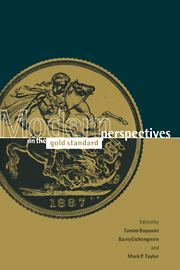Book contents
- Frontmatter
- Contents
- List of figures
- List of tables
- Notes on the contributors
- I Introduction
- II Operation of the gold standard
- 3 The gold standard as a commitment mechanism
- 4 Market efficiency and regime efficiency under the 1925–1931 dollar/sterling gold standard
- 5 Credibility and fundamentals: were the Classical and interwar gold standards well-behaved target zones?
- III Adjustment mechanisms
- IV Monetary issues
- V Exchange rate behavior
- VI Conclusions
- Index
5 - Credibility and fundamentals: were the Classical and interwar gold standards well-behaved target zones?
Published online by Cambridge University Press: 05 November 2011
- Frontmatter
- Contents
- List of figures
- List of tables
- Notes on the contributors
- I Introduction
- II Operation of the gold standard
- 3 The gold standard as a commitment mechanism
- 4 Market efficiency and regime efficiency under the 1925–1931 dollar/sterling gold standard
- 5 Credibility and fundamentals: were the Classical and interwar gold standards well-behaved target zones?
- III Adjustment mechanisms
- IV Monetary issues
- V Exchange rate behavior
- VI Conclusions
- Index
Summary
Introduction
This chapter investigates the question of whether the international gold standard constituted a credible target zone. The question is not a narrow one, for the answer has a bearing on whether adherence to the gold standard was sufficient to render monetary policy time consistent. That is, did the markets believe that the authorities were truly committed to the international standard, or were the policies adopted seen as threatening the link with gold? Since the Classical gold standard lasted from c. 1873 until 1914 and, according to economic historians, operated more or less according to the “rules of the game,” it would not be so surprising to find that during this long period the authorities did create a credible reputation for responsible monetary and interest rate policies. It may be somewhat more surprising if it was to be found that the troubled and short-lived reconstituted interwar gold standard of 1925 to 1931 was similarly credible. This is one of the key issues which we investigate in this chapter.
The literature on the theory of freely floating exchange rates – which typically uses the asset approach – is normally formulated using a linear relationship between an exchange rate and its fundamental determinants, say, the quantity of money and its velocity of circulation (see, for example, the well known works of Dornbusch, 1976; Frenkel, 1976; Mussa, 1976).
- Type
- Chapter
- Information
- Modern Perspectives on the Gold Standard , pp. 129 - 162Publisher: Cambridge University PressPrint publication year: 1997
- 9
- Cited by



